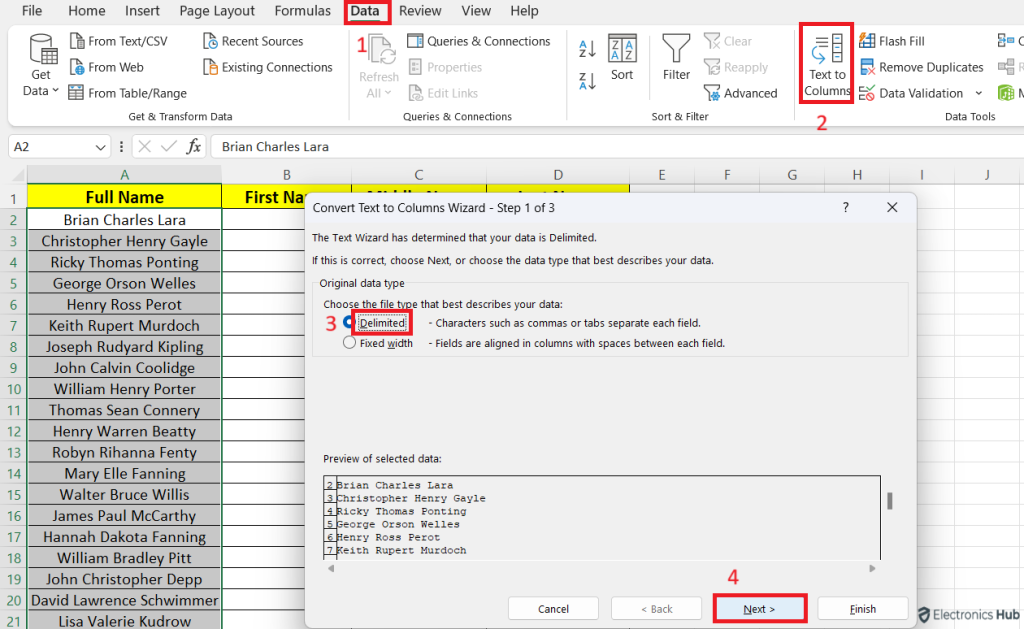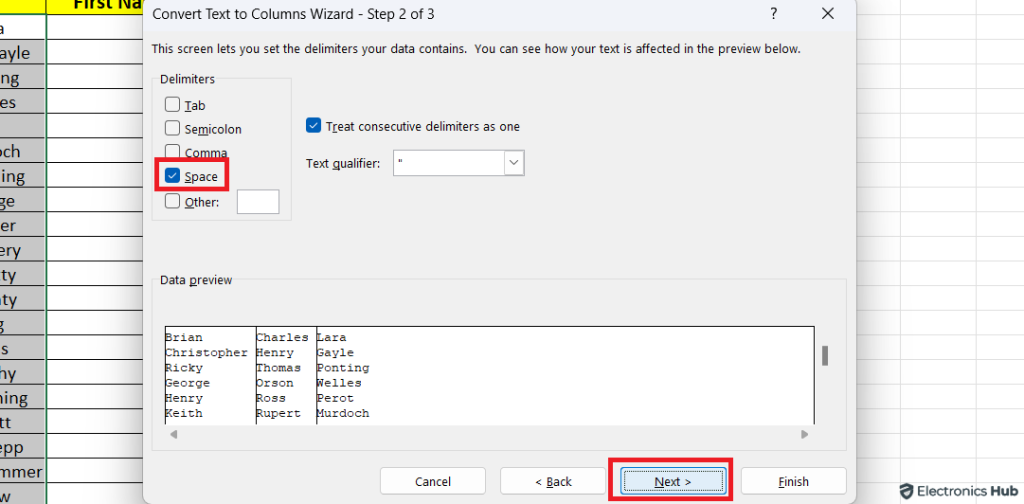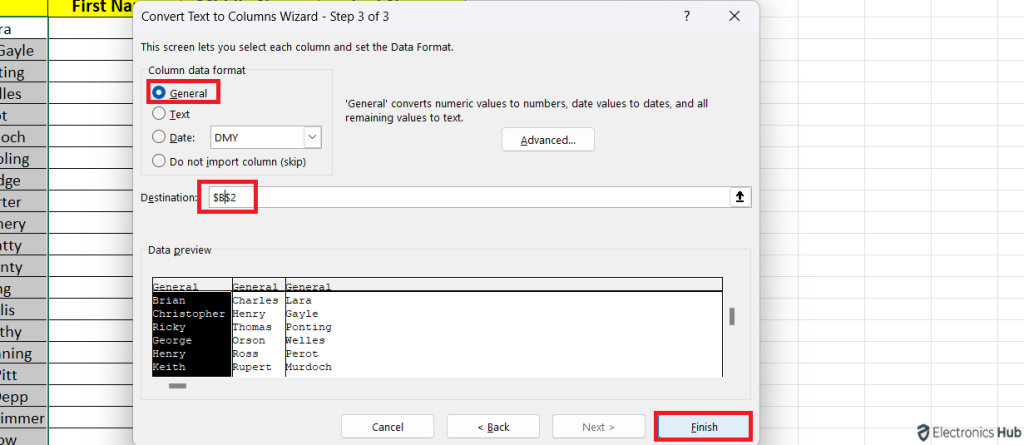In Excel, separating names is essential for organizing and analysing data. Excel has a number of ways to make tasks easier, regardless of whether you’re working with a single column that contains entire names or you need to separate first and last names from a more extensive dataset. In this article, we’ll look at practical ways to break names into different columns, which will help you organize your spreadsheets for better clarity and functionality and handle your data more efficiently. Whether you’re dealing with a list of names for students, business connections, or any other purpose, becoming proficient in these approaches can strengthen your Excel abilities and improve data processing efficiency.
Outline
Toggle- What is Split Name in Excel?
- What is the Purpose of Separating Names in Excel?
- When Might You Need to Separate Names in Excel?
- What are the Different Ways to Separate Names in Excel?
- How to Handle Names With Middle Names?
- How to Split First, Middle and Last Names From Full Names With Space?
- How to Separate First and Last Names From Names With Commas?
- How to Handle Compound Names ( First, Last, and Middle name)?
- How to Separate Names With Flash Fill?
- Common Challenges When Separating First & Last Names in Your Excel
- How to Separate First and Last Names in an Excel Spreadsheet?
- Separate Names in Excel – FAQs
- Conclusion
What is Split Name in Excel?
The term “Split Name” in Excel describes the division of a complete name, which is usually seen in a single column, into distinct columns for the first and last names. This process is frequently used when you analyse or arrange data based on individual first and last names in a dataset containing whole names. Depending on your particular needs and the version of Excel you’re using, splitting names can be accomplished using a variety of Excel functions, including Text to Columns, Flash Fill, or a mix of text manipulation capabilities like LEFT, RIGHT, MID, and FIND. This essential Excel data manipulation operation enhances data structure and analysis.
What is the Purpose of Separating Names in Excel?
Excel’s name separator provides a number of crucial functions.
1. Analysis of Data: You can analyse and sort data more efficiently by splitting names. For instance, you can use last name sorting to arrange a list of names alphabetically, which will help you locate certain people or see patterns in the data.
2. Customization: First and surname names should appear in separate columns when working with client databases or email lists. This allows for individualized communication, such as referring to people by their first names in email marketing campaigns.
3. Lists by Mail: Having names separated is necessary for tasks like making mailing labels or personalized messages. This makes sure that formatting and printing labels addresses correctly are simple tasks.
4. Input and Verification of Data: Because it enables you to verify and standardize name formats, maintaining consistency in your dataset, separating names can assist in reducing data entry errors.
5. Search and Filter: By splitting names, you may identify specific names or subsets of your data more quickly and effectively using Excel’s search and filter features.
6. Presentations and Reports: Putting your first and last names in different columns when creating reports or presentations can help them look more professional and be more straightforward to read.
7. Interface With Databases: Splitting names is frequently necessary when importing data into a database since specific database systems require first and last names to be in distinct fields.
When Might You Need to Separate Names in Excel?
1. Selection and Reduction: Separating names can help you locate particular people or groups more quickly when sorting and filtering data by last name.
2. Personalized Communication: To address recipients by their first names in personalized email marketing, first and last names must be separated.
3. Lists by Mail: Having names divided into distinct columns when making mailing lists or labels guarantees proper address formatting.
4. Data Validation: Separated names contribute to data standardization and validation, which lowers data entry errors.
5. Search and Retrieval: Separated names facilitate the process of finding and locating particular individuals within a sizable dataset.
6. Confirmation: Separating names improves readability and presentation quality for reports and presentations that seem professional.
7. Interface With Databases: First and last names must be entered separately in many database systems, which requires data import.
8. Analysis of Surnames: When analysing data based on common surnames, like in genealogy research, it is helpful to separate names.
9. Formatting of Name: It enables you to format names uniformly so that they appear consistently throughout your databases and documents.
10. Data Exportation: Using distinct names when exporting data to other programs or platforms guarantees accuracy and compatibility in the destination system.
What are the Different Ways to Separate Names in Excel?
1. Text to Columns
One of Excel’s most useful features for splitting names is Text to Columns. It uses a chosen delimiter, such as a space, to divide a full name in a single cell into distinct columns, usually first name and last name. This tool’s versatility and ease of use allow for the rapid separation and organization of large datasets. You can increase data accuracy and facilitate effective filtering, sorting, and personalized communication with a few easy steps. Text to Columns is an essential tool for anyone using Excel for data management and analysis, and it comes in particularly useful when working with mixed data.
2. Formulas
Excel formulas provide a dynamic and effective way to divide names. You can break down full names into first and last name components by using tools like LEFT, RIGHT, MID, and FIND. Because of the formulas’ flexibility, you can adjust them to different name formats and data sets. They also guarantee that your separation process is automated, which makes it scalable for managing large amounts of data. Additionally, they can be integrated into Excel spreadsheets to guarantee accurate and consistent data organization.
How to Handle Names With Middle Names?
Handling names with middle names in Excel can be a little more challenging, but it is still possible with some tweaks. Using text manipulation functions such as LEFT, RIGHT, and MID in conjunction with FIND or SUBSTITUTE functions is one method. Using the LEFT or MID function, you can extract the first name first and then use SUBSTITUTE to remove the extracted first name from the original cell. Next, you can apply a similar technique to extract the last name. The middle name will be the remaining part, if any. However, the consistency of your data determines how effective this method will be. It may be necessary to create a custom VBA (Visual Basic for Applications) macro in order to handle middle names accurately if there is more significant variability in name formats. The secret to effectively managing names with middle names in Excel is to tailor the strategy to the unique requirements of your dataset.
How to Split First, Middle and Last Names From Full Names With Space?
The built-in Text to Columns feature in Excel can be used to separate first and last names from full names when there is a space between the names. As follows:
- Please choose a column. To begin, choose the column with the names you wish to divide.
- Open the Excel ribbon and select the “Data” tab.
- Select “Text to Columns” from the Data Tools group by clicking on it.
- Since the names are separated by a character (a space in this case), select the “Delimited” option in the Text to Columns Wizard.
- Choose the delimiter “Space”. Excel will automatically show you how your data will be split in the Data Preview section.
- Indicate the locations of the split names, which should generally be in columns next to each other to the right of your original data.
- Press “Finish” to bring the procedure to a close.
The full names will then be divided into two columns by Excel, with the first names appearing in one column and the last names in the other. This simple method functions well if names are formatted consistently with a space as the delimiter.
How to Separate First and Last Names From Names With Commas?
Excel’s Text to Columns feature and text manipulation functions can be used to separate first and last names from names containing commas.
1. Column Text: Choose the column containing the names first. Next, select “Text to Columns” under the “Data” tab, then “Delimited.” Choose “Comma” as the delimiter in the resulting window to split the names at the commas.
2. Modifying the Outcome: This format works well for names that have a space and comma, such as “Last Name, First Name.” Your last names will be in one column after the division, and your first names will be in the column next to it.
3. Dessert: Once the names are separated, you might need to deal with existing middle names or remove leading or trailing spaces. You can perform extra Text-to-column operations and utilize tools like TRIM if needed.
This procedure can be modified to accommodate different name formats in your dataset and efficiently separates first and last names from names that contain commas.
How to Handle Compound Names ( First, Last, and Middle name)?
In Excel, managing compound names containing first, last, and middle names requires a more sophisticated method. You can combine the Text to Columns feature with text manipulation tools like LEFT, RIGHT, MID, and FIND for particular formatting. First, you can extract the first and last names using the LEFT and RIGHT functions and then remove them from the original cell if the middle name is consistently positioned between the first and last names. Next, divide the middle name using Text to Columns and space as the delimiter. To extract all name components reliably, you might need to use a formula that finds patterns in the data or a custom VBA macro if the formatting differs.
How to Separate Names With Flash Fill?
Separating names with Flash Fill in Excel is a quick and user-friendly method. Follow these steps:
1. Data Preparation: Ensure your dataset is well-structured. If you have names in a single column and want to separate them into different columns for first and last names, make sure the names are consistent in their formatting.
2. Create Destination Columns: Insert two empty columns following the column containing the full names. These columns will be used to store the separated first and last names.
3. Activate Flash Fill:
- In the first empty cell next to a full name (in the “First Name” column), start typing the first name as you would like it to appear.
- As you type, Excel automatically detects the pattern and suggests the complete transformation.
- Press “Enter” to accept the suggestion. Excel will fill in the first name for that row.
4. Repeat for Last Name: In the adjacent empty cell (in the “Last Name” column), type the desired last name. Excel will again suggest the transformation, and you can accept it by pressing “Enter.”
5. Autofill: Excel will continue to apply the Flash Fill transformation to the remaining rows in the columns, automatically separating first & last names.
Flash Fill is a powerful tool that can recognize patterns in your data and save you time when separating names or performing other data transformations in Excel. It’s particularly useful when the data follows consistent patterns, but it may not work as effectively with highly variable or irregular data.
Common Challenges When Separating First & Last Names in Your Excel
Although it’s a standard data manipulation task, first and last name separation in Excel presents a few common challenges. One of these difficulties is handling different name formats, like “Last Name, First Name” or “First Name, Last Name.” The process can be complicated by inconsistent formatting and using initials or middle names, which frequently necessitates extra steps to guarantee accurate separation.
Additionally, names containing diacritical marks, hyphens, or special characters could cause problems during the separation process, and having extra spaces inside or around names could affect the outcome. Data cleaning, unique formulas, and text manipulation tools are frequently required to get past these obstacles, so it’s critical to modify your strategy depending on the particulars of your dataset.
Tips for Cleaning Up Data Before Separating First and Last Names in Excel
How to Separate First and Last Names in an Excel Spreadsheet?
Separating first and last names in an Excel spreadsheet is a fundamental data manipulation task that can significantly enhance data organization and analysis. To achieve this, you can follow a systematic process:
1. Data Preparation: Ensure your dataset is structured consistently, with names all contained in a single column. Make sure there are no extra spaces or special characters that could interfere with the separation process.
2. Insert Columns: Insert two new columns following the column containing the full names. These will be used to store the separated first and last names.
3. Text to Columns: Select all the columns with full names, go to the “Data” tab, and choose “Text to Columns.” In the Wizard, select “Delimited” and click “Next.”
4. Delimiter Selection: Choose the delimiter that separates the first and last names. This is a space in many cases, but it could be a comma or another character, depending on your data.
5. Destination: Specify the two new columns where you want to place the separated first and last names, and then click “Finish.”
Excel will automatically split the full names into first and last names based on your chosen delimiter, saving you time and improving data integrity. However, be aware of potential challenges, such as middle names or variations in name formatting, which may require additional steps to address.
Also Check: How To Move (Swap) Columns In Excel?
Separate Names in Excel – FAQs
Ans: You can use the SPLIT function to quickly divide names into Sheets. Enter the formula in a neighbouring cell (let’s say the name is in cell A2 and space is the delimiter) like this: =SPLIT(A2, ” “). This formula effectively divides The entire name into distinct first and last name columns, speeding up and simplifying the procedure.
Ans: You can use text manipulation functions like LEFT, RIGHT, or MID to separate partial text in Excel. To extract the desired portion of the text, specify the length and starting point. It’s helpful for tasks like splitting phone numbers or extracting substrings from a larger text, for example, because you can extract specific characters from a cell’s content.
Ans: The Flash Fill feature in Excel is the quickest way to split names. Excel will quickly and effectively separate names by creating two empty columns following the column containing the full names. Then, begin typing the first entry’s desired first and last names. Excel will then intelligently autofill the remaining spaces based on the pattern.
Conclusion
Excel name separation is an essential skill for effective data management. Understanding how to divide a dataset containing names into first and last names can significantly enhance data accuracy, organization, and analytical capabilities—whether you’re working with customer databases, contact lists, or any other type of dataset containing names. Excel provides several ways to accomplish this, such as Text to Columns, formulas, and Flash Fill; which one you use will depend on the complexity and consistency of your data. Accurate separation depends on comprehending and overcoming common obstacles, such as middle names or different formats. Gaining proficiency with this ability will enable you to work with data more efficiently, allowing for individualized communication, sorting, and filtering, as well as improving the general calibre of your spreadsheets.






